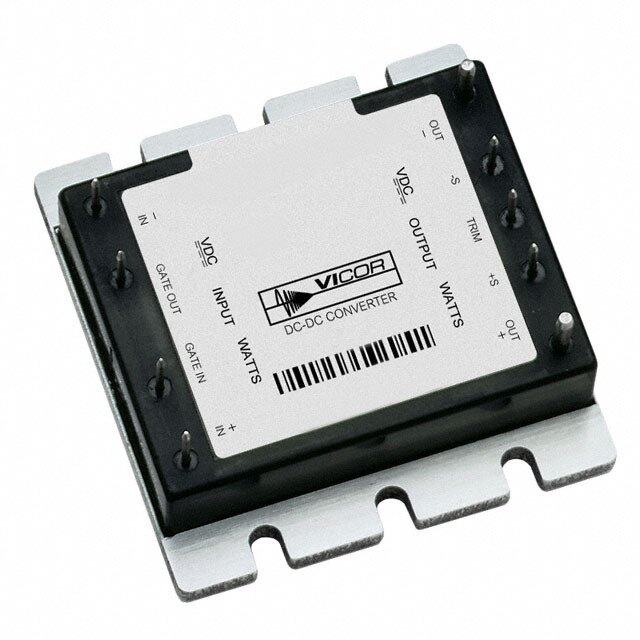- 型号: V375C28C150BL
- 制造商: Vicor
- 库位|库存: xxxx|xxxx
- 要求:
| 数量阶梯 | 香港交货 | 国内含税 |
| +xxxx | $xxxx | ¥xxxx |
查看当月历史价格
查看今年历史价格
V375C28C150BL产品简介:
ICGOO电子元器件商城为您提供V375C28C150BL由Vicor设计生产,在icgoo商城现货销售,并且可以通过原厂、代理商等渠道进行代购。 V375C28C150BL价格参考。VicorV375C28C150BL封装/规格:直流转换器, 隔离模块 DC/DC 转换器 1 输出 28V 5.36A 250V - 425V 输入。您可以下载V375C28C150BL参考资料、Datasheet数据手册功能说明书,资料中有V375C28C150BL 详细功能的应用电路图电压和使用方法及教程。
| 参数 | 数值 |
| 产品目录 | |
| 描述 | CONVERTER MOD DC/DC 28V 150W |
| 产品分类 | DC DC Converters |
| 品牌 | Vicor Corporation |
| 数据手册 | |
| 产品图片 |
|
| 产品型号 | V375C28C150BL |
| rohs | 含铅 / 不符合限制有害物质指令(RoHS)规范要求 |
| 产品系列 | 微型 |
| 其它名称 | 1102-1394 |
| 功率(W)-制造系列 | 150W |
| 功率(W)-最大值 | 150W |
| 包装 | 散装 |
| 大小/尺寸 | 2.28" 长 x 1.45" 宽 x 0.65" 高(57.9mm x 36.8mm x 16.5mm) |
| 安装类型 | 通孔 |
| 封装/外壳 | 四分之一砖 |
| 工作温度 | -20°C ~ 100°C |
| 效率 | 86% |
| 标准包装 | 1 |
| 特性 | OVP,UVLO |
| 电压-输入(最大值) | 425V |
| 电压-输入(最小值) | 250V |
| 电压-输出1 | 28V |
| 电压-输出2 | - |
| 电压-输出3 | - |
| 电压-隔离 | 3kV(3000V) |
| 电流-输出(最大值) | 5.36A |
| 相关产品 | /product-detail/zh/ATS-1141-C1-R0/ATS1500-ND/4146482/product-detail/zh/ATS-1139-C1-R0/ATS1499-ND/4146481/product-detail/zh/ATS-1138-C1-R0/ATS1498-ND/4146480/product-detail/zh/ATS-1099-C1-R0/ATS1496-ND/4146479/product-detail/zh/ATS-1098-C1-R0/ATS1495-ND/4146478/product-detail/zh/ATS-1101-C1-R0/ATS1497-ND/4146471 |
| 类型 | 隔离模块 |
| 设计资源 | |
| 输出数 | 1 |

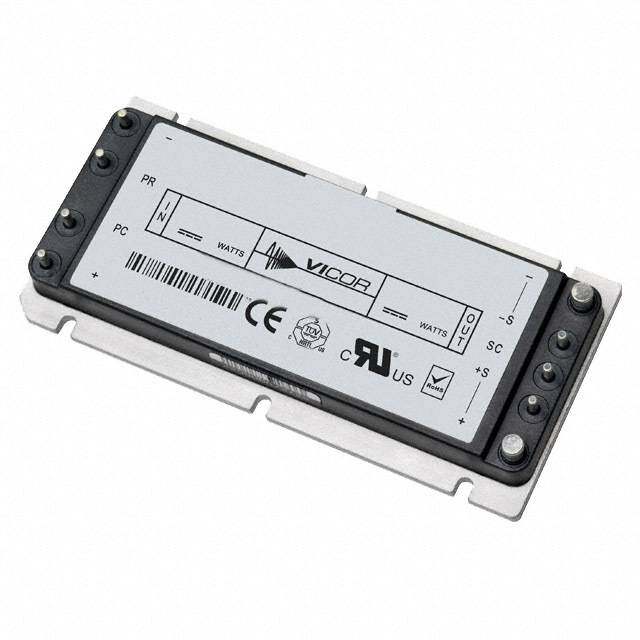



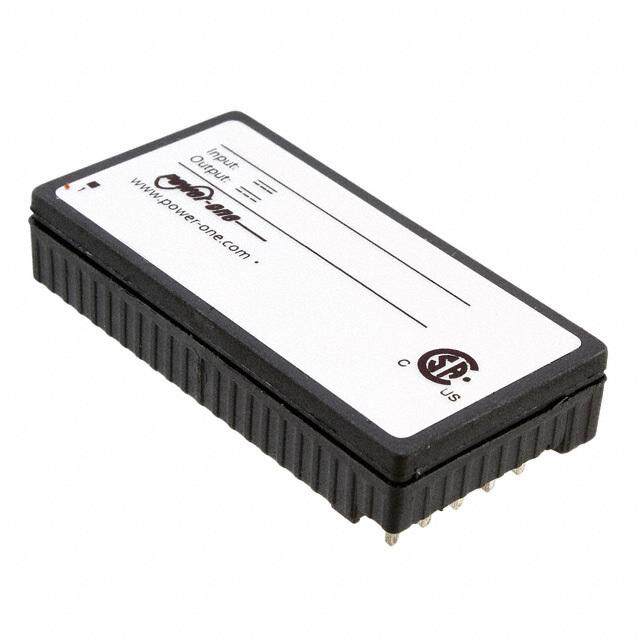
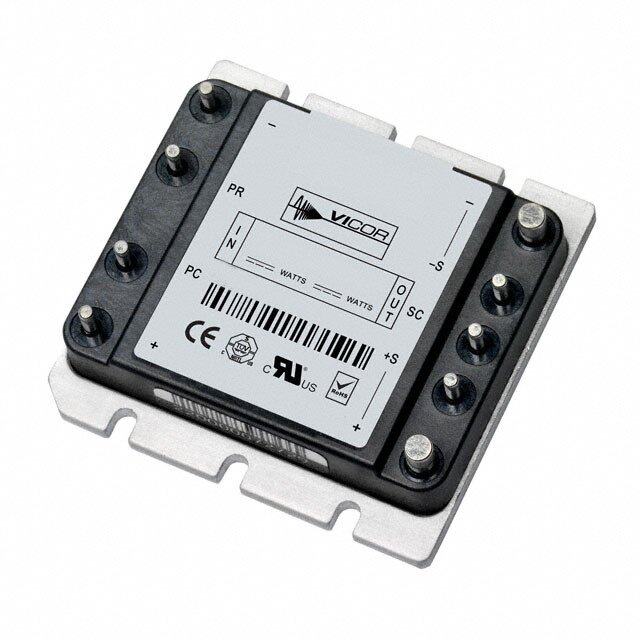


- 商务部:美国ITC正式对集成电路等产品启动337调查
- 曝三星4nm工艺存在良率问题 高通将骁龙8 Gen1或转产台积电
- 太阳诱电将投资9.5亿元在常州建新厂生产MLCC 预计2023年完工
- 英特尔发布欧洲新工厂建设计划 深化IDM 2.0 战略
- 台积电先进制程称霸业界 有大客户加持明年业绩稳了
- 达到5530亿美元!SIA预计今年全球半导体销售额将创下新高
- 英特尔拟将自动驾驶子公司Mobileye上市 估值或超500亿美元
- 三星加码芯片和SET,合并消费电子和移动部门,撤换高东真等 CEO
- 三星电子宣布重大人事变动 还合并消费电子和移动部门
- 海关总署:前11个月进口集成电路产品价值2.52万亿元 增长14.8%

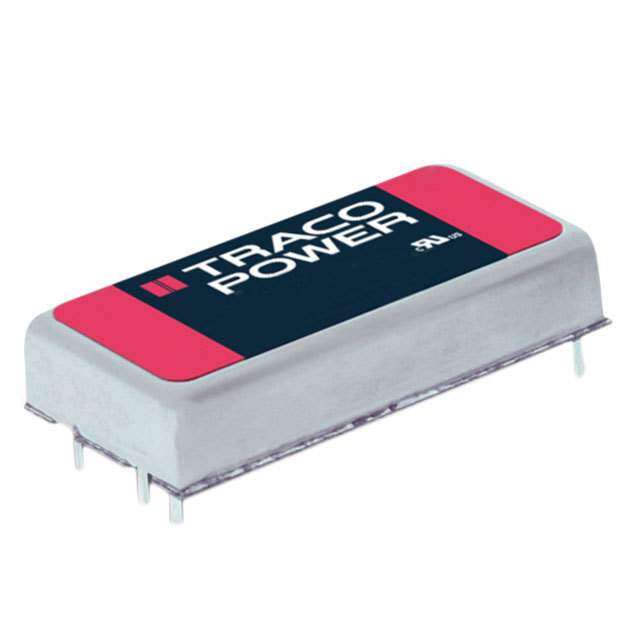

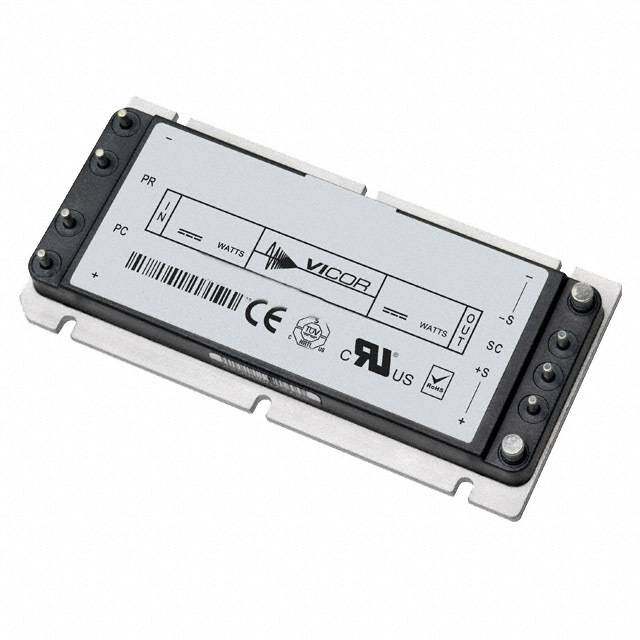
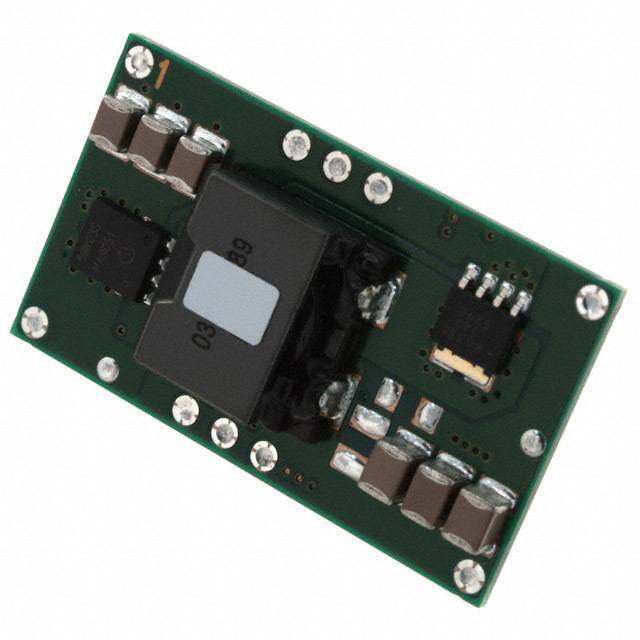

PDF Datasheet 数据手册内容提取
Micro Family 375V Input Actual size: 2.28 x 1.45 x 0.5in ® S [57,9 x 36,8 x 12,7mm] C US C NRTL US DC-DC Converter Module Features & Benefits Applications • DC input range: 250 – 425V Industrial and process control, distributed power, medical, ATE, communications, defense and aerospace. • Isolated output For details on proper operation please refer to the: • Input surge withstand: 500V for 100ms Design Guide & Applications Manual for Maxi, Mini, Micro Family. • DC output: 2 – 48V • Programmable output: 10 – 110% Absolute Maximum Ratings • Regulation: ±0.5% no load to full load • Efficiency: Up to 88% Parameter Rating Unit Notes • Maximum operating temp: 100°C, +IN to –IN voltage –0.5 to +525 VDC full load PC to –IN voltage –0.5 to +7.0 V DC • Power density: up to 90W per cubic inch PR to –IN voltage –0.5 to +7.0 VDC • Height above board: 0.43in [10,9mm] SC to –OUT voltage –0.5 to +1.5 VDC Isolation voltage • Parallelable, with N+M fault tolerance IN to OUT 3000 V Test voltage RMS • Low-noise ZCS/ZVS architecture IN to base 1500 V Test voltage RMS • RoHS Compliant (with F or G pin option) OUT to base 500 V Test voltage RMS Operating Temperature –55 to +100 °C M-Grade Product Overview Storage Temperature –65 to +125 °C M-Grade These DC-DC converter modules use advanced 500 [260] °F [°C] <5sec; wave solder Pin soldering temperature power processing, control and packaging 750 [390] °F [°C] <7sec; hand solder technologies to provide the performance, Mounting torque 5 [0.57] in.lbs [N.m] 6 each flexibility, reliability and cost effectiveness of a mature power component. High-frequency ZCS/ZVS switching provides high power density with low noise and high efficiency. Part Numbering e.g. V375C12T150BL2 375C B Product Type Output Voltage Product Grade Temperatures (°C) Output Power Pin Style Finish Baseplate VS == eSEftnfiahncaidenancrcedyd 3V235 === N35.V/3AV G rCEa d e == ––12O00p ettoora ++ti11n00g00 ––24S00t ottoora ++g11e2255 V23V.O3U VT P55O00UWWT , 75W BLS::l aLSnohkno:gr tS hMoortd uMate TTiinnG//oLLeeldaa dd B23::l aTTnhhkrreo: auSdgloehtd-the do le (avail. ≤12 8 = 8V T = –40 to +100 –40 to +125 5V 50W, 100W N: Long ModuMate Gold VOUT only) 1125 == 1125VV MH == ––4505 ttoo ++110000 ––5655 ttoo ++112255 81V2V 17050WW, 150W FG:: SLhoonrgt RRooHHSS GGoolldd 24 = 24V 15V 75W, 150W K: Extra Long RoHS Gold 28 = 28V 24V 75W, 150W 36 = 36V 28V 75W, 150W 48 = 48V 36V 75W, 150W 48V 75W, 150W Note: Product images may not highlight current product markings. 375V Micro Family Rev 10.0 Page 1 of 14 08/2020
375V Input Module Family Electrical Characteristics Electrical characteristics apply over the full operating range of input voltage, output load (resistive) and baseplate temperature, unless otherwise specified. All temperatures refer to the operating temperature at the center of the baseplate. Module Input Specifications Parameter Min Typ Max Unit Notes Operating input voltage 250 375 425 V DC Input surge withstand 500 V <100ms DC Undervoltage turn-on 242.5 247.5 V DC Undervoltage turn-off 204.7 212.2 V DC Overvoltage turn-off/on 429.2 446.3 467.5 V DC Disabled input current 1.1 mA PC pin low Module Output Specifications Parameter Min Typ Max Unit Notes Output voltage set point ±1 % Of nominal output voltage. Nominal input; full load; 25°C Line regulation ±0.02 ±0.20 % Low line to high line; full load Temperature regulation ±0.002 ±0.005 % / °C Over operating temperature range Power sharing accuracy ±2 ±5 % 10 – 100% of full load Of nominal output voltage. For trimming below 90% Programming range 10 110 % of nominal, a minimum load of 10% of maximum rated power may be required. +OUT to –OUT — Absolute Maximum Ratings 2V –0.5 to 3.1 V Externally Applied DC 3.3V –0.5 to 4.7 V Externally Applied DC 5V –0.5 to 7.0 V Externally Applied DC 8V –0.5 to 10.9 V Externally Applied DC 12V –0.5 to 16.1 V Externally Applied DC 15V –0.5 to 20.0 V Externally Applied DC 24V –0.5 to 31.7 V Externally Applied DC 28V –0.5 to 36.9 V Externally Applied DC 36V –0.5 to 47.1 V Externally Applied DC 48V –0.5 to 62.9 V Externally Applied DC Note: The permissible load current must never be exceeded during normal, abnormal or test conditions. For additional output related application information, please refer to output connections on page 9. Thermal Resistance and Capacity Parameter Min Typ Max Unit Baseplate to sink; flat, greased surface 0.24 °C/Watt Baseplate to sink; thermal pad (P/N 20265) 0.21 °C/Watt Baseplate to ambient 10.9 °C/Watt Baseplate to ambient; 1000LFM 2.8 °C/Watt Thermal capacity 48 Watt-sec/°C 375V Micro Family Rev 10.0 Page 2 of 14 08/2020
375V Input Module Family Electrical Characteristics (Cont.) Module Control Specifications Parameter Min Typ Max Unit Notes Primary Side (PC = Primary Control; PR = Parallel) PC bias voltage 5.50 5.75 6.00 V PC current = 1.0mA DC current limit 1.5 2.1 3.0 mA PC voltage = 5.5V PC module disable 2.3 2.6 2.9 V Switch must be able to sink ≥4mA. See Figure 2 DC PC module enable delay 4 7 ms PC module alarm 0.5 Vavg UV, OV, OT, module fault. See Figures 3 and 5 PC resistance 0.9 1.0 1.1 MΩ See Figure 3, converter off or fault mode PR emitter amplitude 5.7 5.9 6.1 Volts PR load >30Ω, <30pF PR emitter current 150 mA PR receiver impedance 375 500 625 Ω 25°C PR receiver threshold 2.4 2.5 2.6 Volts Minimum pulse width: 20ns PR drive capability 12 modules Without PR buffer amplifier Secondary Side (SC = Secondary Control) SC bandgap voltage 1.21 1.23 1.25 V Referenced to –Sense DC SC resistance 990 1000 1010 Ω SC capacitance 0.033 µF SC module alarm 0 V With open trim; referenced to –Sense. See Figure 7 DC Module General Specifications Parameter Min Typ Max Unit Notes Isolation test voltage (IN to OUT)* 3000 V Complies with reinforced insulation requirements RMS Isolation test voltage (IN to base)* 1500 V Complies with basic insulation requirements RMS Isolation test voltage (OUT to base)* 500 V Complies with operational insulation requirements RMS Isolation resistance 10 MΩ IN to OUT, IN to baseplate, OUT to baseplate 1.9 2.1 2.3 ounces Weight (E, C, T grade) [52.8] [59.3] [65.8] [grams] 2.1 2.3 2.5 ounces Weight (H, M grade) [58.7] [65.2] [71.7] [grams] Temperature limiting 100 115 °C See Figures 3 and 5. Do not operate coverter >100°C. UL60950-1, EN60950-1, CSA60950-1, IEC60950-1. Agency approvals cURus, cTÜVus, CE With appropriate fuse in series with the +Input * Isolation test voltage, 1 minute or less. Note: Specifications are subject to change without notice. 375V Micro Family Rev 10.0 Page 3 of 14 08/2020
375V Input Module-Specific Operating Specifications 2V , 50W (e.g. S375C2C50BL, V375C2C50BL) OUT Parameter Min Typ Max Unit Notes Efficiency S375C2C50BL (enhanced efficiency) 78.0 81.0 % Nominal input; 75% load; 25°C V375C2C50BL (standard efficiency) 72 73.9 Ripple and noise 80 100 mV P-P; Nominal input; full load; 20MHz bandwidth Output OVP set point 2.7 2.8 2.9 Volts 25°C; recycle input voltage or PC to restart (>100ms off) Dissipation, standby 2.5 3.5 Watts No load Load regulation ±0.02 ±0.2 % No load to full load; nominal input Load current 0 25 Amps Current limit 25.5 28.8 33.8 Amps Output voltage 95% of nominal Short circuit current 17.5 28.8 33.8 Amps Output voltage <250mV 3.3V , 75W (e.g. S375C3V3C75BL, V375C3V3C75BL) OUT Parameter Min Typ Max Unit Notes Efficiency S375C3V3C75BL (enhanced efficiency) 82.0 85.0 % Nominal input; 75% load; 25°C V375C3V3C75BL (standard efficiency) 79.0 80.5 Ripple and noise 94 118 mV P-P; Nominal input; full load; 20MHz bandwidth Output OVP set point 4.14 4.3 4.46 Volts 25°C; recycle input voltage or PC to restart (>100ms off) Dissipation, standby 3.9 5.9 Watts No load Load regulation ±0.02 ±0.4 % No load to full load; nominal input Load current 0 22.7 Amps Current limit 23.1 24.6 30.6 Amps Output voltage 95% of nominal Short circuit current 15.8 24.6 30.6 Amps Output voltage <250mV 3.3V , 50W (e.g. S375C3V3C50BL, V375C3V3C50BL) OUT Parameter Min Typ Max Unit Notes Efficiency S375C3V3C50BL (enhanced efficiency) 80.0 83.0 % Nominal input; 75% load; 25°C V375C3V3C50BL (standard efficiency) 75.7 77 Ripple and noise 140 175 mV P-P; Nominal input; full load; 20MHz bandwidth Output OVP set point 4.14 4.3 4.46 Volts 25°C; recycle input voltage or PC to restart (>100ms off) Dissipation, standby 3.4 4 Watts No load Load regulation ±0.02 ±0.2 % No load to full load; nominal input Load current 0 15.15 Amps Current limit 15.5 17.5 20.6 Amps Output voltage 95% of nominal Short circuit current 10.6 17.5 20.6 Amps Output voltage <250mV 5V , 100W (e.g. S375C5C100BL, V375C5C100BL) OUT Parameter Min Typ Max Unit Notes Efficiency S375C5C100BL (enhanced efficiency) 81.3 82.3 % Nominal input; 75% load; 25°C V375C5C100BL (standard efficiency) 80 81.8 Ripple and noise 120 150 mV P-P; Nominal input; full load; 20MHz bandwidth Output OVP set point 6.03 6.25 6.47 Volts 25°C; recycle input voltage or PC to restart (>100ms off) Dissipation, standby 3.1 5.5 Watts No load Load regulation ±0.02 ±0.2 % No load to full load; nominal input Load current 0 20 Amps Current limit 20.4 23 26 Amps Output voltage 95% of nominal Short circuit current 14 23 26 Amps Output voltage <250mV 375V Micro Family Rev 10.0 Page 4 of 14 08/2020
375V Input Module-Specific Operating Specifications (Cont.) 5V , 50W (e.g. S375C5C50BL, V375C5C50BL) OUT Parameter Min Typ Max Unit Notes Efficiency S375C5C50BL (enhanced efficiency) 83.5 85.0 % Nominal input; 75% load; 25°C V375C5C50BL (standard efficiency) 79.5 80.9 Ripple and noise 120 150 mV P-P; Nominal input; full load; 20MHz bandwidth Output OVP set point 6.03 6.25 6.47 Volts 25°C; recycle input voltage or PC to restart (>100ms off) Dissipation, standby 2.7 3.4 Watts No load Load regulation ±0.02 ±0.2 % No load to full load; nominal input Load current 0 10 Amps Current limit 10.2 11.5 13.5 Amps Output voltage 95% of nominal Short circuit current 7 11.5 13.5 Amps Output voltage <250mV 8V , 100W (e.g. S375C8C100BL, V375C8C100BL) OUT Parameter Min Typ Max Unit Notes Efficiency S375C8C100BL (enhanced efficiency) 84.0 87.0 % Nominal input; 75% load; 25°C V375C8C100BL (standard efficiency) 82.5 83.7 Ripple and noise 180 225 mV P-P; Nominal input; full load; 20MHz bandwidth Output OVP set point 9.36 9.7 10.1 Volts 25°C; recycle input voltage or PC to restart (>100ms off) Dissipation, standby 3.6 4.2 Watts No load Load regulation ±0.02 ±0.2 % No load to full load; nominal input Load current 0 12.5 Amps Current limit 12.7 14.4 16.9 Amps Output voltage 95% of nominal Short circuit current 8.75 14.4 16.9 Amps Output voltage <250mV 12V , 150W (e.g. S375C12C150BL, V375C12C150BL) OUT Parameter Min Typ Max Unit Notes Efficiency S375C12C150BL (enhanced efficiency) 85.0 86.0 % Nominal input; 75% load; 25°C V375C12C150BL (standard efficiency) 85.0 86.0 Ripple and noise 220 275 mV P-P; Nominal input; full load; 20MHz bandwidth Output OVP set point 13.7 14.3 14.9 Volts 25°C; recycle input voltage or PC to restart (>100ms off) Dissipation, standby 5.4 7.4 Watts No load Load regulation ±0.02 ±0.2 % No load to full load; nominal input Load current 0 12.5 Amps Current limit 12.7 14.4 16.9 Amps Output voltage 95% of nominal Short circuit current 8.75 14.4 17.5 Amps Output voltage <250mV 12V , 75W (e.g. S375C12C75BL, V375C12C75BL) OUT Parameter Min Typ Max Unit Notes Efficiency S375C12C75BL (enhanced efficiency) 85.0 88.0 % Nominal input; 75% load; 25°C V375C12C75BL (standard efficiency) 84.0 85.5 Ripple and noise 100 125 mV P-P; Nominal input; full load; 20MHz bandwidth Output OVP set point 13.7 14.3 14.9 Volts 25°C; recycle input voltage or PC to restart (>100ms off) Dissipation, standby 3.5 4 Watts No load Load regulation ±0.02 ±0.2 % No load to full load; nominal input Load current 0 6.25 Amps Current limit 6.37 7.19 8.44 Amps Output voltage 95% of nominal Short circuit current 4.37 7.19 8.44 Amps Output voltage <250mV 375V Micro Family Rev 10.0 Page 5 of 14 08/2020
375V Input Module-Specific Operating Specifications (Cont.) 15V , 150W (e.g. V375C15C150BL) OUT Parameter Min Typ Max Unit Notes Efficiency 85.5 86.8 % Nominal input; 75% load; 25°C Ripple and noise 224 280 mV P-P; Nominal input; full load; 20MHz bandwidth Output OVP set point 17.1 17.8 18.5 Volts 25°C; recycle input voltage or PC to restart (>100ms off) Dissipation, standby 5 7.5 Watts No load Load regulation ±0.02 ±0.2 % No load to full load; nominal input Load current 0 10 Amps Current limit 10.2 11.5 13.5 Amps Output voltage 95% of nominal Short circuit current 7 11.5 13.5 Amps Output voltage <250mV 15V , 75W (e.g. V375C15C75BL) OUT Parameter Min Typ Max Unit Notes Efficiency 85.0 86.5 % Nominal input; 75% load; 25°C Ripple and noise 100 125 mV P-P; Nominal input; full load; 20MHz bandwidth Output OVP set point 17.1 17.8 18.5 Volts 25°C; recycle input voltage or PC to restart (>100ms off) Dissipation, standby 3.4 4 Watts No load Load regulation ±0.02 ±0.2 % No load to full load; nominal input Load current 0 5 Amps Current limit 5.1 5.75 6.75 Amps Output voltage 95% of nominal Short circuit current 3.5 5.75 6.75 Amps Output voltage <250mV 24V , 150W (e.g. V375C24C150BL) OUT Parameter Min Typ Max Unit Notes Efficiency 85.0 86.0 % Nominal input; 75% load; 25°C Ripple and noise 135 169 mV P-P; Nominal input; full load; 20MHz bandwidth Output OVP set point 27.1 28.1 29.1 Volts 25°C; recycle input voltage or PC to restart (>100ms off) Dissipation, standby 5.4 8.1 Watts No load Load regulation ±0.02 ±0.2 % No load to full load; nominal input Load current 0 6.25 Amps Current limit 6.37 7.19 8.13 Amps Output voltage 95% of nominal Short circuit current 4.37 7.19 8.13 Amps Output voltage <250mV 24V , 75W (e.g. V375C24C75BL) OUT Parameter Min Typ Max Unit Notes Efficiency 84.0 85.1 % Nominal input; 75% load; 25°C Ripple and noise 120 150 mV P-P; Nominal input; full load; 20MHz bandwidth Output OVP set point 27.1 28.1 29.1 Volts 25°C; recycle input voltage or PC to restart (>100ms off) Dissipation, standby 2.2 5 Watts No load Load regulation ±0.02 ±0.2 % No load to full load; nominal input Load current 0 3.13 Amps Current limit 3.19 3.6 4.23 Amps Output voltage 95% of nominal Short circuit current 2.19 3.6 4.23 Amps Output voltage <250mV 375V Micro Family Rev 10.0 Page 6 of 14 08/2020
375V Input Module-Specific Operating Specifications (Cont.) 28V , 150W (e.g. V375C28C150BL) OUT Parameter Min Typ Max Unit Notes Efficiency 85 86.1 % Nominal input; 75% load; 25°C Ripple and noise 150 188 mV P-P; Nominal input; full load; 20MHz bandwidth Output OVP set point 31.5 32.7 33.9 Volts 25°C; recycle input voltage or PC to restart (>100ms off) Dissipation, standby 5 7.5 Watts No load Load regulation ±0.02 ±0.2 % No load to full load; nominal input Load current 0 5.36 Amps Current limit 5.46 6.16 6.97 Amps Output voltage 95% of nominal Short circuit current 3.75 6.16 6.97 Amps Output voltage <250mV 28V , 75W (e.g. V375C28C75BL) OUT Parameter Min Typ Max Unit Notes Efficiency 84.0 85.3 % Nominal input; 75% load; 25°C Ripple and noise 100 125 mV P-P; Nominal input; full load; 20MHz bandwidth Output OVP set point 31.5 32.7 33.9 Volts 25°C; recycle input voltage or PC to restart (>100ms off) Dissipation, standby 4.3 5.4 Watts No load Load regulation ±0.02 ±0.2 % No load to full load; nominal input Load current 0 2.68 Amps Current limit 2.73 3.08 3.62 Amps Output voltage 95% of nominal Short circuit current 1.87 3.08 3.62 Amps Output voltage <250mV 36V , 150W (e.g. V375C36C150BL) OUT Parameter Min Typ Max Unit Notes Efficiency 84.6 86 % Nominal input; 75% load; 25°C Ripple and noise 80 100 mV P-P; Nominal input; full load; 20MHz bandwidth Output OVP set point 40.4 41.9 43.4 Volts 25°C; recycle input voltage or PC to restart (>100ms off) Dissipation, standby 5.4 6.7 Watts No load Load regulation ±0.02 ±0.2 % No load to full load; nominal input Load current 0 4.17 Amps Current limit 4.25 4.8 5.63 Amps Output voltage 95% of nominal Short circuit current 2.91 4.8 5.63 Amps Output voltage <250mV 36V , 75W (e.g. V375C36C75BL) OUT Parameter Min Typ Max Unit Notes Efficiency 83 85 % Nominal input; 75% load; 25°C Ripple and noise 160 200 mV P-P; Nominal input; full load; 20MHz bandwidth Output OVP set point 40.4 41.9 43.4 Volts 25°C; recycle input voltage or PC to restart (>100ms off) Dissipation, standby 4.0 6.5 Watts No load Load regulation ±0.02 ±0.2 % No load to full load; nominal input Load current 0 2.08 Amps Current limit 2.12 2.39 2.81 Amps Output voltage 95% of nominal Short circuit current 1.45 2.39 2.81 Amps Output voltage <250mV 375V Micro Family Rev 10.0 Page 7 of 14 08/2020
375V Input Module-Specific Operating Specifications (Cont.) 48V , 150W (e.g. V375C48C150BL) OUT Parameter Min Typ Max Unit Notes Efficiency 85.3 86.3 % Nominal input; 75% load; 25°C Ripple and noise 90 113 mV P-P; Nominal input; full load; 20MHz bandwidth Output OVP set point 53.7 55.7 57.7 Volts 25°C; recycle input voltage or PC to restart (>100ms off) Dissipation, standby 5.7 8.6 Watts No load Load regulation ±0.02 ±0.2 % No load to full load; nominal input Load current 0 3.13 Amps Current limit 3.19 3.6 4.38 Amps Output voltage 95% of nominal Short circuit current 2.19 3.6 4.38 Amps Output voltage <250mV 48V , 75W (e.g. V375C48C75BL) OUT Parameter Min Typ Max Unit Notes Efficiency 83 84.1 % Nominal input; 75% load; 25°C Ripple and noise 200 250 mV P-P; Nominal input; full load; 20MHz bandwidth Output OVP set point 53.7 55.7 57.7 Volts 25°C; recycle input voltage or PC to restart (>100ms off) Dissipation, standby 4.2 5 Watts No load Load regulation ±0.02 ±0.2 % No load to full load; nominal input Load current 0 1.56 Amps Current limit 1.59 1.79 2.11 Amps Output voltage 95% of nominal Short circuit current 1.09 1.79 2.11 Amps Output voltage <250mV 375V Micro Family Rev 10.0 Page 8 of 14 08/2020
375V Input Basic Module Operation C2* C4* 4.7nF 4.7nF +IN +OUT F1* PC C1* SC 0.2µF PR –IN –OUT C3* C5* 4.7nF 4.7nF For C1 – C5, keep leads and connections short. Figure 1 — Basic module operation requires fusing, grounding, bypassing capacitors.* See Maxi, Mini, Micro Design Guide. Output Connections and Considerations remote-sense circuit is used, the remote-sense leads must be protected for conditions such as lead reversal, noise pickup, open The permissible load current must never be exceeded during circuit or excessive output lead resistance between the sense normal, abnormal or test conditions. Converters subject to dynamic point and the converters output terminals. For applications that loading exceeding 25% of rated current must be reviewed by may draw more than the rated current, a fast-acting electronic Vicor Applications Engineering to ensure that the converter will circuit breaker must be utilized to protect the converter. Under operate properly. no circumstance should the rated current be exceeded. Utilizing Under dynamic-load, light-load or no-load conditions, the converter or testing of current limit or short circuit current will damage the may emit audible noise. Converters that utilize remote sense may converter. Ensure that the total output capacitance connected to require compensation circuitry to offset the phase lag caused the converter does not exceed the limits on Page 16, “Maximum by the external output leads and load impedance. If an external Output Capacitance”, of the design guide. Comprehensive Online Application Information The Design Guide and Applications Manual includes: • Application circuits • Design requirements • EMC considerations • Current sharing in power arrays • Thermal performance information • Recommended soldering methods • Accessory modules – filtering, rectification, front-ends • Mounting options • ...and more. CLICK HERE TO VIEW DESIGN GUIDE Also at vicorpower.com • PowerBench online configurators • Over 20 Application Notes • Online calculators – thermal, trimming, hold-up • PDF data sheets for ALL Vicor products 375V Micro Family Rev 10.0 Page 9 of 14 08/2020
375V Input Primary Control – PC Pin Module Enable/Disable Module Alarm The module may be disabled by pulling PC to 0V (2.3V max) with The module contains “watchdog” circuitry which monitors input respect to the –Input. This may be done with an open collector voltage, operating temperature and internal operating parameters. transistor, relay, or optocoupler. Converters may be disabled with In the event that any of these parameters are outside of their a single transistor or relay either directly or via “OR’ing” diodes for allowable operating range, the module will shut down and PC will two or more converters. See Figure 2. go low. PC will periodically go high and the module will check to see if the fault (as an example, Input Undervoltage) has cleared. Primary Auxiliary Supply If the fault has not been cleared, PC will go low again and the cycle will restart. The SC pin will go low in the event of a fault During normal operation only, the PC Pin can source 5.7V and return to its normal state after the fault has been cleared. See @ 1.5mA. In the example shown in Figure 4, PC powers a Figures 3 and 5. module enabled LED. Input Undervoltage +IN +OUT +IN IOnvpeurt TOevmeprveorlatatugree +OUT Module Faults Auto Restart PC PC SW1 50Ω PR SC PR 2 – 2f(0VmINs) typ. SW2 SW3 1kΩ SC Disable 1MΩ (05 –.7 3VmDCA) 6kΩ 1.23 –IN –OUT –IN SW1, 2, & 3 shown VDC –OUT in "Fault" position Disable = PC < 2.3V Figure 2 — Module enable/disable Figure 3 — PC/SC module alarm logic +IN +OUT Fault 40µs typ. 5.7V PC PC 4kΩ SC "Module PR Enabled" SC 1.23V 2-20ms typ. –IN –OUT Figure 4 — LED on-state indicator Figure 5 — PC/SC module alarm timing Optocoupler +IN +IN +OUT +OUT Comparator PC PC SC SC 4k PR PR Alarm 1.00V –IN –IN –OUT –OUT Figure 6 — Isolated on-state indicator Figure 7 — Secondary side on-state indicator 375V Micro Family Rev 10.0 Page 10 of 14 08/2020
375V Input Secondary Control – SC Pin Compatible interface architectures include the following: AC-coupled single-wire interface. All PR pins are connected to a Output Voltage Programming single communication bus through 0.001µF (500V) capacitors. This The output voltage of the converter can be adjusted or interface supports current sharing and is fault tolerant except for programmed via fixed resistors, potentiometers or voltage the communication bus. Up to three converters may be paralleled DACs. See Figure 8. by this method. See Figure 9. Transformer-coupled interface. For paralleling four or more converters a transformer-coupled interface is required, and under certain conditions a PR buffer circuit. +IN +OUT RU For details on parallel operation please refer to the PC Trim Up Error Design Guide & Applications Manual for Maxi, Mini, Micro Family. Amp SC Load PR 1kΩ 0.033μF TRrDim Down –IN –OUT 1.23V 4.7nF + +IN 0.2µF PC 0.001µF R1* Module 1 RD (Ω) = V1N,O0M0 0–V VOOUUTT – P–IRN Low inductance 4.7nF RU (Ω ) = 1,000 (VOUT – 1.23) VNOM – 1,000 gorro buunsd plane 1.23 (V – V ) 4.7nF OUT NOM +IN Figure 8 — Output voltage trim-down and trim-up circuit 0.2µF PC Module 2 0.001µF R1* PR Trim Down –IN 4.7nF 1. This converter is not a constant-power device – it has a Parallel Bus constant current limit. Hence, available output power is reduced by the same percentage that output voltage is Figure 9 — AC-coupled single-wire interface trimmed down. Do not exceed maximum rated output current. * See Maxi, Mini, Micro Design Guide 2. The trim-down resistor must be connected between the SC and –S pins. Do not bypass the SC pin directly with a capacitor. 4.7nF + +IN Trim Up 0.2µF PC 1. The converter is rated for a maximum delivered power. To T1 R1* PR Module 1 ensure that maximum rated power is not exceeded, reduce –IN maximum output current by the same percentage increase in – 4.7nF output voltage. 4.7nF 2. The trim-up resistor must be connected between the SC and +IN +S pins. Do not bypass the SC pin directly with a capacitor. 0.2µF PC Module 2 T2 R1* 3. Do not trim the converter above maximum trim range (typically PR +10%) or the output over voltage protection circuitry may –IN be activated. 4.7nF Parallel Bus Trim resistor values calculated automatically: Figure 10 — Transformer-coupled interface On-line calculators for trim resistor values are available on the vicor website at: Number of Converters in Parallel *R1 value Ω asp.vicorpower.com/calculators/calculators.asp?calc=1 Resistor values can be calculated for fixed trim up, fixed 2 75 trim down and for variable trim up or down. 3 50 4 33 Parallel Bus – PR Pin 5 or more refer to application note: Designing High-Power Arrays Parallel Operation using Maxi, Mini, Micro The PR pin supports paralleling for increased power with N+1 Family DC-DC Converters (N+M) redundancy. Modules of the same input voltage, output voltage, and power level will current share if all PR pins are suitably interfaced. 375V Micro Family Rev 10.0 Page 11 of 14 08/2020
375V Input Parallel Bus / Voltage-Drop Compensation +OUT • The +OUT and –OUT Plane Module #1 power buses should be Designated SC designed to minimize +OUT and balance parasitic +S Parent –OUT imlmoaopdde.udlaen oceu tfproumt t oea tchhe SC R1* R2* U1 2.RR51531 k 1.RR0506Rk4*TLUV4231C1 R07.2C 2221µ.F0k4–.R082k VCc–3c* R9* R Load +OUT PS2701 36.5k 1.65k 470pF + 200mV + R10 Module #2 L • At the discretion of the LMU310Gnd 1.24k tdroimwmn e2d% SC ODA pa oswubesre sty ostfe amll dmeosdigunleesr, –OUT –S within an array may be –OUT configured as children *See Component Selection section below. by connecting SC to –OUT. • This module is designed for point-of-load regulation, where remote sensing is +OUT not required. Active voltage-drop compensator, as shown here, may be used Module #3 • Do not use output in applications with significant distribution losses. trimmed SC down 4% Ground OR’ing diodes with Plane MicroMods. Please consult with the Micro Family Isolated Remote Sense Application Note –OUT for additional information. Figure 11 — N+1 module array output connections Figure 12 — Voltage-drop compensation Pin Styles* Designator Description Finish Notes (None) Short Tin/Lead Requires inboard mounting L Long Tin/Lead Onboard mounting for 0.065in boards S Short ModuMate Gold SurfMate or inboard socket mounting N Long ModuMate Gold Onboard socket mounting F Short RoHS Gold Select for RoHS-compliant inboard solder, socket or SurfMate mounting G Long RoHS Gold Select for RoHS-compliant onboard solder or socket mounting K Extra Long RoHS Gold Select for RoHS compliance on-board mounting for thicker PCBs (not intended for socket or Surfmate mounting) * Pin style designator follows the “B” after the output power and precedes the baseplate designator. Ex. V375C12T150BN2 — Long ModuMate Pins Storage Vicor products, when not installed in customer units, should be stored in ESD safe packaging in accordance with ANSI/ESD S20.20, “Protection of Electrical and Electronic Parts, Assemblies and Equipment” and should be maintained in a temperature controlled factory/ warehouse environment not exposed to outside elements controlled between the temperature ranges of 15°C and 38°C. Humidity shall not be condensing, no minimum humidity when stored in an ESD compliant package. 375V Micro Family Rev 10.0 Page 12 of 14 08/2020
375V Input Mechanical Drawings Converter Pins No. Function Label 1 +IN + Ref Dwg. 37207 rev 5 Primary 2 PC Control 3 Parallel PR 4 –IN – 5 –OUT – Secondary 6 SC Control 7 +OUT + SLOTTED BASEPLATE 2. DIMENSIONS AND VALUES IN BRACKETS ARE METRIC 3. MANUFACTURING CONTROL IS IN PLACE TO ENSURE THAT THE SPACING BETWEEN THE MODULES LABEL SURFACE TO THE PRINTED CIRCUIT BOARD OF THE APPLICATION RANGES FROM DIRECT CONTACT (ZERO), TO THE MAXIMUM GAP AS CALCULATED FROM THE TOLERANCE STACK-UP AND IS NOT SUBJECT NEGATIVE TOLERANCE ACCUMULATION Figure 13 — Module outline ALL MARKINGS ALL MARKINGS THIS SURFACE THIS SURFACE PCB THICKNESS 0.10,6527 ±±00.,02150 PCB THICKNESS 0.10,6527 ±±00.,02150 0.800* 0.800* 20,32 20,32 INBOARD ONBOARD ININBBOOAARRDD ONOBNOBAORADRD INBOARD ONBOARD 103.5,3245* 103.5,3245* SMOOLUDNETR SMOOLUDNETR SMSMOOOOLCUDUKNENETRTT SUSMROOFSLAUODCNCEETKR METOUNT SMOOCUKNETT SURFSAOCCEK METOUNT 03.1,0646.852,9*795* THPRLUDA TIHAEODLE03.1,338303.1,0646.852,9*795* (7X)SHO0 .2R0,T9T34 9HPP ±R±ILN00UDA. ,0S TI0HA08ETO3YDLLEE03.1,33L83O0N .2G0,93 P49 I ±N±00 S.,00T08Y3LE (7X)SHO0 0.2R 0.4,1ST93,86O4 9P35 C±± I±±N00K00. ,E0S0.,000T8T083Y3LE LOS0N .2UG0,R93 P49F I A±N±NC00 S.,/E00AT 08MY3LOEUNT PSMAB0IOLAO N.4USL1SDS,MD8E6OU 35SPEICMN TLR±±KUAYA00:ETTT.M,L00ITEEEN08:S3 /GL EOALDD PPLLAASTTUEERDDF ACNCO/EAP PMEORUNT PSMABIOLAONUSLDSMDEU SPEIMNTLRUAYA:TTTMLIEEEN:S /GL EOALDD PPLLAATTEEDD COPPER 1 2 3 4 1 2 3 4 RoHS: GOLD PLATED COPPER RoHS: GOLD PLATED COPPER For Soldering Methods and Procedures 2.000* 1.734** 2.000* 1.734** 50,80 44,04 50,80 44,04 Please refer to: The Maxi, Mini, Micro Design Guide. 7 6 5 7 6 5 Unless otherwise specified, R 01.,056(4X) 1.400,11206.7*0,9609** **D*PECNBO WTREINS01D .T,05OO6WL( 4=X ±)±00.0,0083 1.400,11206.7*0,9609** 011.4,55**D*PECNBO WTEINSD TOOWL = ±±0001.0,.3050,8353 SO011.C104,1.5K54,7E6TS SOCKE01T.3015, .435H5,62EADERS SOC101.K4,7E6TSd D i 0em .c Xe i mXn s ai o l sn Ss Oa r e ± C± T00i Kn o.. 02E li 1.5n T 01 cm .4hH5m,e62EsADAnE±g1Rl°eSs 0.080" DIA PINS (7X) (SURFACE MOUNT) 0.080" DIA PINS ( 70X.X)XX (SU±R0F.0A0C5E MOUNT) P/N 13632 (100 pcs.) KIT INCLUDES P/N 13632 (100 p cs.) K ±IT0. 1IN27CLUDES P/N 16023 (7 pc. kit) INPUT & OUTPUT P/N 16023 (7 pc. kit) INPUT & OUTPUT P/N 16025 P/N 16025 Figure 14 — PCB mounting specifications 375V Micro Family Rev 10.0 Page 13 of 14 08/2020
375V Input Vicor’s comprehensive line of power solutions includes high density AC-DC and DC-DC modules and accessory components, fully configurable AC-DC and DC-DC power supplies, and complete custom power systems. Information furnished by Vicor is believed to be accurate and reliable. However, no responsibility is assumed by Vicor for its use. Vicor makes no representations or warranties with respect to the accuracy or completeness of the contents of this publication. Vicor reserves the right to make changes to any products, specifications, and product descriptions at any time without notice. Information published by Vicor has been checked and is believed to be accurate at the time it was printed; however, Vicor assumes no responsibility for inaccuracies. Testing and other quality controls are used to the extent Vicor deems necessary to support Vicor’s product warranty. Except where mandated by government requirements, testing of all parameters of each product is not necessarily performed. Specifications are subject to change without notice. Visit http://www.vicorpower.com/dc-dc-converters-board-mount/high-density-dc-dc-converters for the latest product information. Vicor’s Standard Terms and Conditions and Product Warranty All sales are subject to Vicor’s Standard Terms and Conditions of Sale, and Product Warranty which are available on Vicor’s webpage (http://www.vicorpower.com/termsconditionswarranty) or upon request. Life Support Policy VICOR’S PRODUCTS ARE NOT AUTHORIZED FOR USE AS CRITICAL COMPONENTS IN LIFE SUPPORT DEVICES OR SYSTEMS WITHOUT THE EXPRESS PRIOR WRITTEN APPROVAL OF THE CHIEF EXECUTIVE OFFICER AND GENERAL COUNSEL OF VICOR CORPORATION. As used herein, life support devices or systems are devices which (a) are intended for surgical implant into the body, or (b) support or sustain life and whose failure to perform when properly used in accordance with instructions for use provided in the labeling can be reasonably expected to result in a significant injury to the user. A critical component is any component in a life support device or system whose failure to perform can be reasonably expected to cause the failure of the life support device or system or to affect its safety or effectiveness. Per Vicor Terms and Conditions of Sale, the user of Vicor products and components in life support applications assumes all risks of such use and indemnifies Vicor against all liability and damages. Intellectual Property Notice Vicor and its subsidiaries own Intellectual Property (including issued U.S. and Foreign Patents and pending patent applications) relating to the products described in this data sheet. No license, whether express, implied, or arising by estoppel or otherwise, to any intellectual property rights is granted by this document. Interested parties should contact Vicor’s Intellectual Property Department. Contact Us: http://www.vicorpower.com/contact-us Vicor Corporation 25 Frontage Road Andover, MA, USA 01810 Tel: 800-735-6200 Fax: 978-475-6715 www.vicorpower.com email Customer Service: custserv@vicorpower.com Technical Support: apps@vicorpower.com ©2018 – 2020 Vicor Corporation. All rights reserved. The Vicor name is a registered trademark of Vicor Corporation. All other trademarks, product names, logos and brands are property of their respective owners. 375V Micro Family Rev 10.0 Page 14 of 14 08/2020

 Datasheet下载
Datasheet下载


